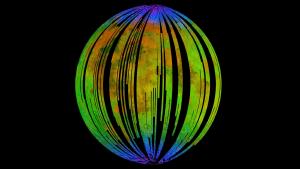Blog
Rusty Dusty Moon
6 September 2020
 ISRO/NASA/JPL-Caltech/Brown University/USGS
ISRO/NASA/JPL-Caltech/Brown University/USGSNew research shows the Moon has rust on its surface, which is quite odd.1 Rust forms when iron reacts with oxygen to form iron oxide. While rust is common on Earth, and even the surface of Mars, its presence on the Moon is unexpected.
The Moon is mostly a dry, airless rock, but it does have traces of water ice near its poles. This was discovered by the Indian Space Research Organization’s Chandrayaan-1 orbiter team in 2008. The team has also located various minerals on the lunar surface, but finding hematite was a surprise. Hematite is a form of iron oxide that typically forms when the iron is exposed to oxygen and liquid water. While other processes can form hematite, these would be hindered by the presence of hydrogen. Hydrogen is present on the lunar surface due to solar wind. So how is hematite forming on the Moon?
 Brian Koberlein
Brian KoberleinThe team has a few ideas. One is that the Moon can be shielded from the solar wind when it passes through the tail of Earth’s magnetic field. This can happen when the Earth is between the Sun and Moon. Another possibility is that micrometeorites strike the Moon on a regular basis. Their impacts could liberate water molecules on the lunar surface while heating the surface enough to allow oxidation to occur when they do.
It’s an exciting mystery, and one more question we’ll try to answer when humans return to the Moon as part of NASA’s Artemis program.
Shuai Li, et al. “Widespread hematite at high latitudes of the Moon.” Science Advances Vol. 6, no. 36, (2020). ↩︎